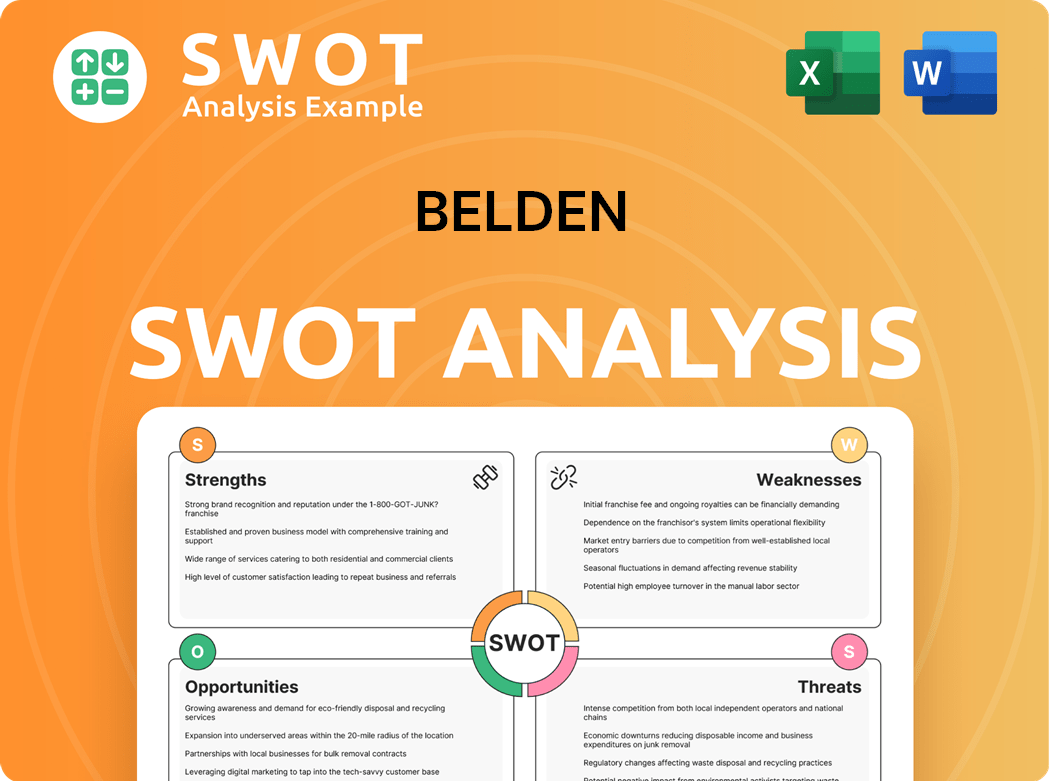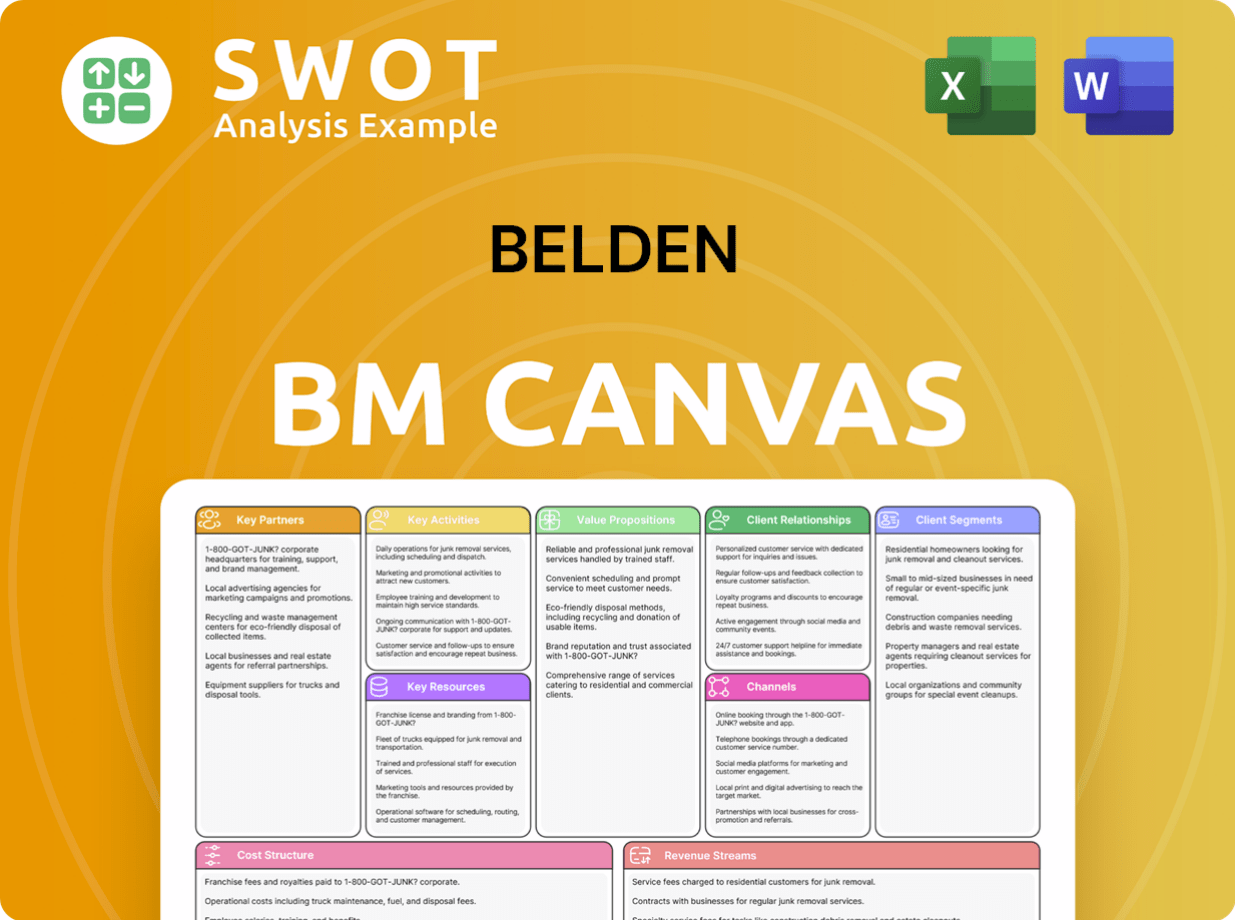Belden Bundle
Who Really Owns Belden?
Unraveling the ownership of Belden Inc. is key to understanding its strategic moves and market position. From its roots in 1902, when Joseph C. Belden established the company to its current global presence, Belden's ownership has shaped its trajectory. Discover the key players influencing this industry leader.

This deep dive into Belden SWOT Analysis will explore the evolution of Belden Company Ownership, from its early investors to its current shareholders. Understanding who owns Belden is essential for anyone tracking Belden Stock, its financial information, and the future of this innovative company. We'll examine the Belden company ownership structure, including major investors, and the influence of the board of directors, providing insights into the company's direction and potential.
Who Founded Belden?
The story of the Belden Company begins in 1902 in Chicago. It was founded by Joseph C. Belden, a Yale University graduate, who saw an opportunity in the growing telephone industry.
Belden, at age 26, identified a need for high-quality silk-insulated magnet wire. He gathered initial capital by selling shares to 11 investors, raising $25,000 to start the business. Joseph C. Belden served as the company's president until 1939.
Joseph Belden partnered with Albert Beutler to bring expertise in wire-making to the venture, with Joseph focusing on the business and Albert on production. This collaboration was key to the company's early success and growth.
Joseph Belden started the company with $25,000 in initial capital.
Belden Manufacturing Company was founded in 1902.
Joseph C. Belden served as president until 1939.
The company initially focused on the burgeoning telephone industry.
Belden's early philosophy was 'sell on quality, not price.'
Belden became a publicly traded company in January 1939.
Belden's early success was built on quality and innovation. The introduction of 'Beldenamel' enamel insulation in 1910 was a significant industry advancement. By 1913, the company's sales nearly tripled to $900,000 due to product line expansions. The company's history is a testament to its early strategic decisions and its ability to adapt to market needs. For more insights, consider exploring the Marketing Strategy of Belden.
- The company was founded in 1902.
- Joseph C. Belden served as president until 1939.
- Belden became a publicly traded company in January 1939.
- The company's early focus was on the telephone industry.
Belden SWOT Analysis
- Complete SWOT Breakdown
- Fully Customizable
- Editable in Excel & Word
- Professional Formatting
- Investor-Ready Format

How Has Belden’s Ownership Changed Over Time?
The ownership of the company has seen several shifts since its inception. Initially known as Belden Manufacturing Company, it was acquired by Crouse-Hinds Company in 1980. This was followed by Cooper Industries' acquisition of Crouse-Hinds in 1981, under which Belden operated as a division. A pivotal moment occurred in 1993 when Cooper Industries spun off Belden, re-establishing it as an independent, publicly traded entity. At the time, it had annual sales of approximately $300 million. The company further evolved in 2004 by merging with Cable Design Technologies, leading to the formation of Belden CDT Inc., later rebranded as Belden Inc. in May 2007. The company's headquarters are located in St. Louis.
As a publicly listed company on the NYSE, Belden Inc. (ticker: BDC) is primarily owned by institutional investors. This structure reflects a trend where large investment firms hold significant stakes, influencing company strategy and operations. Understanding the ownership structure is crucial for investors and stakeholders to assess the company's stability and strategic direction.
| Event | Year | Impact on Ownership |
|---|---|---|
| Acquisition by Crouse-Hinds | 1980 | Belden became part of Crouse-Hinds. |
| Acquisition by Cooper Industries | 1981 | Belden operated as a division of Cooper Industries. |
| Spin-off from Cooper Industries | 1993 | Belden became an independent, publicly traded company. |
| Merger with Cable Design Technologies | 2004 | Formation of Belden CDT Inc. |
| Rebranding to Belden Inc. | 2007 | Changed the company's name to Belden Inc. |
As of May 2025, institutional ownership accounts for roughly 100.45% of Belden's outstanding shares. Key institutional shareholders as of March 30, 2025, include BlackRock, Inc. (13.01%), Fmr LLC (12.44%), and The Vanguard Group, Inc. (12.27%). These large holdings indicate a strong institutional presence, which can influence the company's strategic decisions. For more insights, you can also explore the Competitors Landscape of Belden.
Belden Inc.'s ownership is largely dominated by institutional investors, reflecting its status as a publicly traded company. The ownership structure has evolved significantly over time, from acquisitions to a spin-off, shaping its current form.
- Institutional investors hold a substantial majority of the shares.
- Major shareholders include BlackRock, Fmr LLC, and The Vanguard Group.
- The company's history includes significant corporate transactions.
- Understanding the ownership structure is crucial for investors.
Belden PESTLE Analysis
- Covers All 6 PESTLE Categories
- No Research Needed – Save Hours of Work
- Built by Experts, Trusted by Consultants
- Instant Download, Ready to Use
- 100% Editable, Fully Customizable

Who Sits on Belden’s Board?
The Board of Directors at Belden Inc. is central to the company's governance and strategic direction. While a complete list of current board members and their affiliations isn't immediately available, the board is responsible for key decisions, such as declaring dividends. For instance, a dividend of $0.05 per share was approved, payable on July 9, 2025, to shareholders recorded as of June 12, 2025. Detailed information about the company's corporate governance can be found in its SEC filings, including the Annual Report on Form 10-K for the year ending December 31, 2024, which was filed on February 13, 2025, and in quarterly reports on Form 10-Q.
Belden's commitment to transparency is evident in its regular disclosures regarding changes in the beneficial ownership of securities by company insiders. This provides valuable insight into the holdings of key individuals within the company. The board likely includes a mix of independent directors and those with significant business or industry experience, adhering to established best practices for corporate governance. This structure helps ensure effective oversight and decision-making within the organization. To understand more about the business, you can read about the Revenue Streams & Business Model of Belden.
| Metric | Details | Latest Data |
|---|---|---|
| Dividend per Share | Amount paid to shareholders | $0.05 (July 9, 2025) |
| Form 10-K Filing Date | Annual Report Filing | February 13, 2025 |
| Share Structure | Voting rights | One-share-one-vote |
Belden Inc. operates with a standard one-share-one-vote structure, which is typical for publicly traded companies. Institutional investors often have a significant influence due to their large shareholdings. The company's governance structure is designed to ensure transparency and accountability.
- The board declares dividends.
- SEC filings provide detailed corporate governance information.
- Insiders' holdings are regularly disclosed.
- The company is publicly traded on the NYSE.
Belden Business Model Canvas
- Complete 9-Block Business Model Canvas
- Effortlessly Communicate Your Business Strategy
- Investor-Ready BMC Format
- 100% Editable and Customizable
- Clear and Structured Layout

What Recent Changes Have Shaped Belden’s Ownership Landscape?
Over the past few years, Belden's ownership profile has seen strategic shifts. In 2024, the company focused on acquisitions to boost its market position. Notably, Belden acquired Precision Optical Technologies for $289.6 million and Voleatech GmbH for €5.0 million. These moves expanded its capabilities in optical transceivers and firewall products, aligning with its goal to become a solutions provider.
Belden's capital management strategy includes returning value to shareholders. In 2024, the company repurchased 1.3 million shares of its common stock for $132.9 million. As of February 2025, insider holdings increased from 1.02% to 1.17%, while institutional investors' holdings remained around 104.35%. Mutual funds slightly decreased their holdings from 90.39% to 89.83% during the same period. These actions reflect Belden's commitment to a disciplined capital allocation approach.
| Ownership Category | February 2025 | Previous |
|---|---|---|
| Insiders | 1.17% | 1.02% |
| Institutional Investors | 104.35% | Unchanged |
| Mutual Funds | 89.83% | 90.39% |
Belden's strategy through 2028 centers on expanding its networking and data product portfolio. It includes advancing solutions capabilities and enhancing growth through strategic mergers and acquisitions. The company aims for $8.00 of Adjusted EPS in 2025. Belden anticipates sufficient cash generation to meet its financial obligations, including shareholder returns. Public statements and analyst insights highlight the company's continued focus on acquisitions and share repurchases.
Belden's ownership is primarily composed of institutional investors and mutual funds. Insiders also hold a portion of the company's shares. The company's focus on acquisitions and share repurchases influences its ownership structure.
The primary owners of Belden include institutional investors, mutual funds, and company insiders. The company's financial strategy focuses on returning value to shareholders through share repurchases. Belden's acquisitions also play a role in shaping its ownership profile.
Institutional investors and mutual funds are the major owners of Belden. Insiders also hold a stake, contributing to the company's ownership structure. The company's strategic decisions, such as acquisitions and share buybacks, affect its ownership dynamics.
Belden has a history of strategic acquisitions and capital management. The company aims to grow its portfolio of networking and data products. Belden's focus on acquisitions and shareholder value reflects its long-term strategy.
Belden Porter's Five Forces Analysis
- Covers All 5 Competitive Forces in Detail
- Structured for Consultants, Students, and Founders
- 100% Editable in Microsoft Word & Excel
- Instant Digital Download – Use Immediately
- Compatible with Mac & PC – Fully Unlocked

Related Blogs
- What are Mission Vision & Core Values of Belden Company?
- What is Competitive Landscape of Belden Company?
- What is Growth Strategy and Future Prospects of Belden Company?
- How Does Belden Company Work?
- What is Sales and Marketing Strategy of Belden Company?
- What is Brief History of Belden Company?
- What is Customer Demographics and Target Market of Belden Company?
Disclaimer
All information, articles, and product details provided on this website are for general informational and educational purposes only. We do not claim any ownership over, nor do we intend to infringe upon, any trademarks, copyrights, logos, brand names, or other intellectual property mentioned or depicted on this site. Such intellectual property remains the property of its respective owners, and any references here are made solely for identification or informational purposes, without implying any affiliation, endorsement, or partnership.
We make no representations or warranties, express or implied, regarding the accuracy, completeness, or suitability of any content or products presented. Nothing on this website should be construed as legal, tax, investment, financial, medical, or other professional advice. In addition, no part of this site—including articles or product references—constitutes a solicitation, recommendation, endorsement, advertisement, or offer to buy or sell any securities, franchises, or other financial instruments, particularly in jurisdictions where such activity would be unlawful.
All content is of a general nature and may not address the specific circumstances of any individual or entity. It is not a substitute for professional advice or services. Any actions you take based on the information provided here are strictly at your own risk. You accept full responsibility for any decisions or outcomes arising from your use of this website and agree to release us from any liability in connection with your use of, or reliance upon, the content or products found herein.